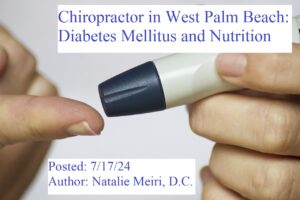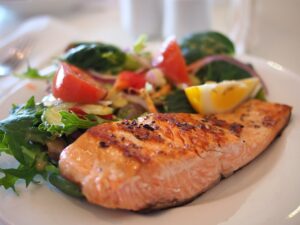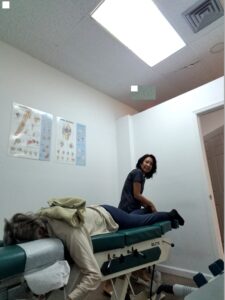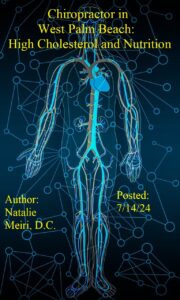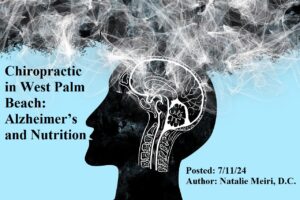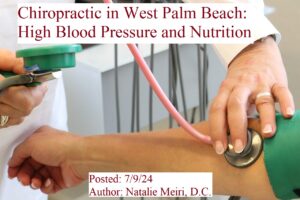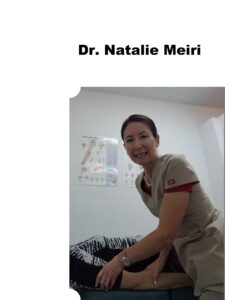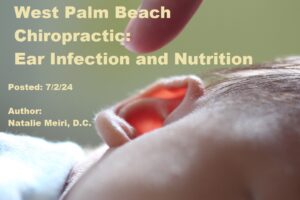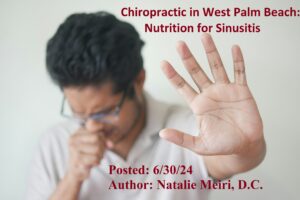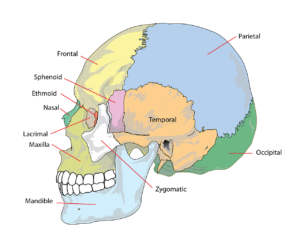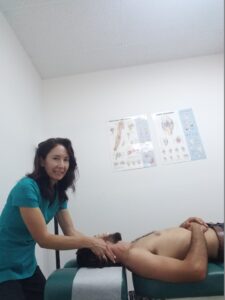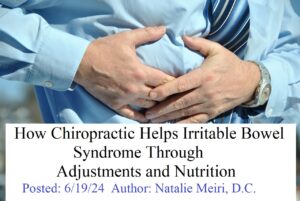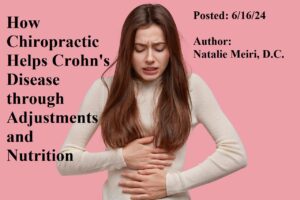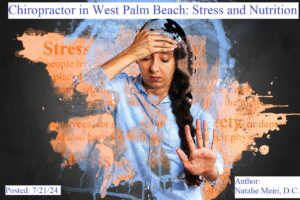
Chiropractor in West Palm Beach: Stress and Nutrition is about how chiropractic and nutrition can help relieve your stress.
Stress is defined as “a physical, chemical, or emotional factor that causes bodily or mental tension and may be a factor in disease causation” (1). Psychosocial stress pervades modern life and is known to have an impact on health. You can experience stress from your environment, your body, and your thoughts. For instance, negative changes such as an illness, injury, job loss, or a relationship break-up can contribute. Similarly, positive changes such as a promotion, a mortgage, or the birth of a child still produce stress.
Chronic stress can lead to physical symptoms such as: headaches, muscle tension in the face, neck, back, shoulder/ chest pain, an upset stomach, elevated blood pressure, exhaustion, sexual dysfunction and menstrual changes, increase or loss of appetite, problems sleeping/insomnia. Anxiety, panic attacks, obsessive-compulsive disorder, post-traumatic stress disorder (PTSD), and phobic disorders are among the more serious emotional manifestations of stress. Many people attribute their stress-related symptoms to “nerves,” and in fact stress usually does affect the parts of the body that are related to the nervous system.
Moreover, a state of continual stress ultimately wears out the body. And it especially effects the immune response and increases susceptibility to illness and slows healing. Researchers estimate that stress contributes to many major illnesses, including cardiovascular disease, cancer, endocrine and metabolic disease, skin disorders, and infectious ailments of all kinds, insomnia or other changes in sleep patterns, and/or gastrointestinal disorders. Most definitely, almost all body functions and organs are effected.

Chiropractor in West Palm Beach: our bodies release stress hormones. These include adrenaline, nor-adrenaline and cortisol. And the hormones create physiological changes to help us cope with the threat or “danger”. And the “fight or flight” response and is apparently designed to prepare one to face an immediate danger.
Firstly, the endocrine system gets activated with stress. The endocrine system plays an important role in regulating mood, growth/ development, tissue function, metabolism and reproductive processes. Furthermore, our metabolism is affected. Your hypothalamus located in the brain plays a key role in connecting the endocrine system with the nervous system. The hypothalamus sends Stress signals to activate the release of stress hormones cortisol and epinephrine (adrenalin) from your adrenal glands. Next, glucose (blood sugar) is produced by your liver to provide the extra energy. Thereafter, most people reabsorb the extra glucose when the stress subsides. However, for some people there is an increased risk of diabetes. Subsequently, the Cortisol released as a consequence to stress suppresses the immune system and inflammatory pathways. As a result, we become more susceptible to infections and chronic inflammatory conditions. In other words, our ability to fight off illness is reduced.
Secondly, stress can effect your gastrointestinal system. Heartburn and acid reflux might begin if you have changed your eating habits. For instance, you may be eating more or less. You may have started eating more fatty and/or sugary foods. So the ability of our intestines to absorb nutrients from our food may be reduced. The result may be stomach pain, bloating and nausea, diarrhea or constipation.
Thirdly, heart rate and blood pressure increase when you are stressed. Once the stress passes, it returns to normal. However, if chronically experienced, damage to blood vessels and arteries may occur. You will have an increased risk for hypertension, heart attack or stroke.
Fourthly, your respiratory system is working to breathe harder and more quickly with stress. This is to quickly distribute oxygen-rich blood around your body. For asthmatics, this could be a problem. For others it can cause hyperventilation. The last scenery is more likely if someone is prone to anxiety and panic attacks.
West Palm Beach Chiropractor: Nutritional Changes to Deal with Stress
Achieving a normal body weight if you are overweight is important to deal better with stress. Also, eating a low-glycemic-load diet, rich in fruits, vegetables, and whole grains, can reduce the risk of developing the diseases associated with stress.
Chiropractor in West Palm Beach: Stress and Nutrition- Helpful Supplementation/Nutritional Recommendations for Stress
Beta-carotene,selenium, and vitamins C and E-as antioxidants to fight damaging free radicals due to stress
Gamma-amino- butyric acid (GABA) -Acts as a natural calming agent and nutrition for the brain.
Glutathione– An antioxidant protects against cell damage
Inositol- a sugar that may help with mood and depression
Nicotinamide adenine dinucleotide(NADH)- helps with generating energy
S-Adenosylmethionine (SAMe)- may help beat depression
Taurine- amino acid for brain and heart function defense
Trimethylglycine (TMG)- helps decrease homocysteine levels in the blood and acts like SAMe to elevate mood and decrease depression.
vitamin B complex plus extra vitamin B5 (pantothenic acid)- for proper nervous system function
Vitamin C with bioflavonoids– to help the overworked adrenal glands
Calcium and magnesium– to replenish lost minerals from stress response
Coenzyme Q10 plus Coenzyme-for increasing energy and function of the heart and immune system.
L-tyrosine– amino acid; essential for the production of brain chemicals called neurotransmitters, including epinephrine, norepinephrine, and dopamine.
Melatonin– may provide better, deeper sleep
Fiber (oat bran or psyllium husks)– for proper bowel movements
Multivitamin and mineral complex- to get all necessary nutrients
Raw adrenal glandular and raw thymus glandular– to help the adrenal and thymus glands, significant in the body’s stress reaction.
Vitamin E– Needed for immune system reaction and also an antioxidant
Zinc– necessary for immune system reaction and for protection from free radical damage
Herbs: Ashwagandha (natural sedative), Ginko Biloba (brain function),Milk thistle (cleanses liver), Catnip (anti-stress and sleep aid),Chamomile (sleep aid and relaxing), Dongquai, chiznadra support kidneys, adrenals and nervous system. Hops( for stress and need for alcohol), Kava Kava (sooths the mind), Passion flower (calming), St John’s wort (for nerve pain), Siberian Ginseng (to endure stress), Skullcap ( relieves headaches and helps with sleep).Valerian (sleep aid)
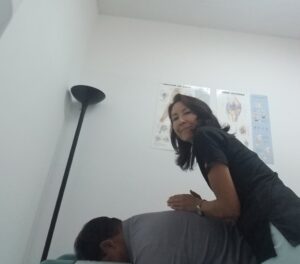
Chiropractor in West Palm Beach: Stress and Nutrition- How can Chiropractic care help ?
- Reduces muscle tension
Chronic back pain is influenced by stress. Chiropractic care can help relieve your stress and anxiety by relieving tension in the neck, back and other stress-related issues. Stress causes your muscles to tense. This impedes your posture when walking and sitting. A chiropractor helps you loosen the tension you are feeling and corrects your posture. Regular adjustments from a chiropractor in West Palm Beach can help your body keep things moving freely. Adjustments will help your joints to move freely and will relieve pressure on veins, arteries, muscles, and underlying structures. The result is improved blood circulation and lymphatic system drainage.
- Optimizes nervous system function
A Chiropractor in West Palm Beach will utilize adjustments to your spine to help restore your autonomic nervous system and body to a natural balance. The autonomic nervous system is a control system that acts largely unconsciously and regulates bodily functions, such as the heart rate, digestion, respiratory rate, pupillary response, urination, and sexual arousal. This system has a built-in stress response that causes physiological changes to allow the body to combat stressful situations. This stress response (“fight or flight response”) is activated in case of an emergency. However, this response can become chronically activated during prolonged periods of stress. Prolonged activation of the stress response causes havoc on the body – both physical and emotional. Chiropractic adjustments sooth your irritated nerves and thereby help deactivate the stress response.
- Personalized patient care
A Chiropractor in West Palm Beach will use natural healing solutions and guide you to develop a program to manage your stress levels unique to your life situation. These various natural strategies include manipulation/ manual therapy , and diet/nutritional recommendations. In addition, a chiropractor in West Palm Beach will give you exercise recommendations and important pointers on how to relax.
During stressful times, a chiropractor in West Palm Beach can help relieve your stress!
In conclusion, chiropractors focus on the evaluation and treatment of neuromusculoskeletal (NMS)-based disorders. However, chiropractors also help manage the multiple potential causes of ill health including acute and chronic stress. Successfully reduce your stress and its consequences with natural chiropractic care!
Are you experiencing stress and need relief? Call your chiropractor in West Palm Beach at 561-253-8984 to make an appointment today or to find out more about Chiropractor in West Palm Beach: Stress and Nutrition.
References
- “Stress.” Merriam-Webster.com Dictionary, Merriam-Webster, https://www.merriam-webster.com/dictionary/stress. Accessed 10 Sep. 2020.
- References: Handbook of Preventative and Therapeutic Nutrition by James M. Gerber,M.S., D.C.
- Prescription for Nutritional Healing (3rd edition), Phyllis A. Balch, CNC
- Thomas Souza, (2018) Differential Diagnosis and Management for the Chiropractor
*Please consult your doctor (M.D. who is monitoring your condition) about the above supplements.
